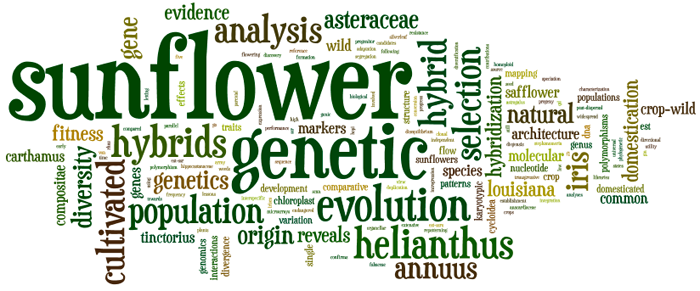Our Research Interests
The word cloud below provides a visual summary of our research interests based on the titles of our past publications. The balance of the page contains a brief overview of ongoing projects in the lab.

Abiotic stress resistance in sunflower and related species
Wild and cultivated plants are regularly challenged by a variety of abiotic stresses resulting from factors such as drought, soil salinization, and low nutrient availability. Though wild plant populations have adapted to many of these challenges, crops are often less resilient. This is likely due to the occurrence of tradeoffs between stress resistance and overall growth/productivity, as well as the loss of genetic diversity during the domestication and breeding of crop plants. To combat stress-induced yield loss and improve food security, attention has turned to the development of stress-resistant crops, but such efforts require knowledge. We are working to understand the genomic and physiological basis of drought, salt, and low nutrient stress resistance in cultivated sunflower and related, stress-adapted wild species. This work is providing basic biological insights into stress adaptation and facilitating the development of more resilient crop plants.
Assessing the fate and impact of crop-wild gene flow
With the commercial introduction of genetically modified crops, it has been feared that genetically engineered genes or “transgenes” might escape into wild relatives through hybridization, possibly generating more invasive weeds and/or causing the decline of herbivore, pathogen, or competing plant populations. In many cases, hybridization between crop plants and their wild relatives is widespread, but our understanding of the factors influencing the movement of crop alleles through wild populations is incomplete. In recent years, we have been working to identify the types of crop-related traits that are likely to provide a selective advantage in wild sunflower populations, and to develop a better understanding of factors favoring the establishment of beneficial crop alleles in such populations. We are also working to characterize historical patterns of crop-wild introgression across the cultivated sunflower production range in the central USA.
Comparative genomics of phenotypic variation
In recent years, we were involved in large-scale, collaborative project aimed at understanding the molecular basis of phenotypic variation across the Compositae (a.k.a. the Asteraceae). The Compositae is one of the largest, most diverse, and most economically important plant families. While sunflower, lettuce, and safflower are the three most valuable crops within the family, over 40 species have been domesticated for a variety of uses. The family also contains some of the world’s most noxious weeds; taken together, these pest species cost the United States ca. $35 billion annually.
Though we have focused most of our attention on crop evolution, we also maintain an interest in the genetic basis of local adaptation in wild populations. In general terms, we use evolutionary approaches to identify genes underlying agriculturally and/or ecologically-important traits. The occurrence of multiple, independently domesticated species that share a number of traits in common (e.g., sunflower [Helianthus annuus] and safflower [Carthamus tinctorius]) provides us with a unique opportunity to investigate the extent to which parallel phenotypic changes have a common genetic basis across lineages.
The evolution of genome structure
Beyond our interest in phenotypic evolution within the Compositae, we are also interested the evolution of genome structure. To this end, we have developed high-density genetic maps for numerous species within the family and have used them to identify structural rearrangements as well as whole-genome duplications. Recently, this work has benefited greatly from our involvement in an international effort aimed at sequencing the sunflower genome. This project has involved the construction and integration of detailed genetic and physical maps of the sunflower genome, the ongoing sequencing, assembly, and annotation of genomes from multiple sunflower genotypes, and detailed analyses of the full complement of genes across the cultivated sunflower gene pool (i.e., characterization of the pan-genome of sunflower).
Hybridization and speciation in Stephanomeria
The genus Stephanomeria (which is likewise a member of the Compositae) contains three particularly interesting cases of speciation. The first is the derivation of S. malheurensis from S. exigua which, contrary to the classical view of how species form, is thought to have occurred in sympatry. The second involves S. diegensis, a diploid hybrid species formed following hybridization between S. exigua and S. virgata. Finally, S. elata is an allopolyploid derived from hybridization between these same two parental species. We are particularly interested in studying the effects of hybridization and polyploidization on the structure and function of the Stephanomeria genome. We have thus been investigating these species in a phylogeographic context, and developing the tools necessary for detailed genomic analyses within the genus.